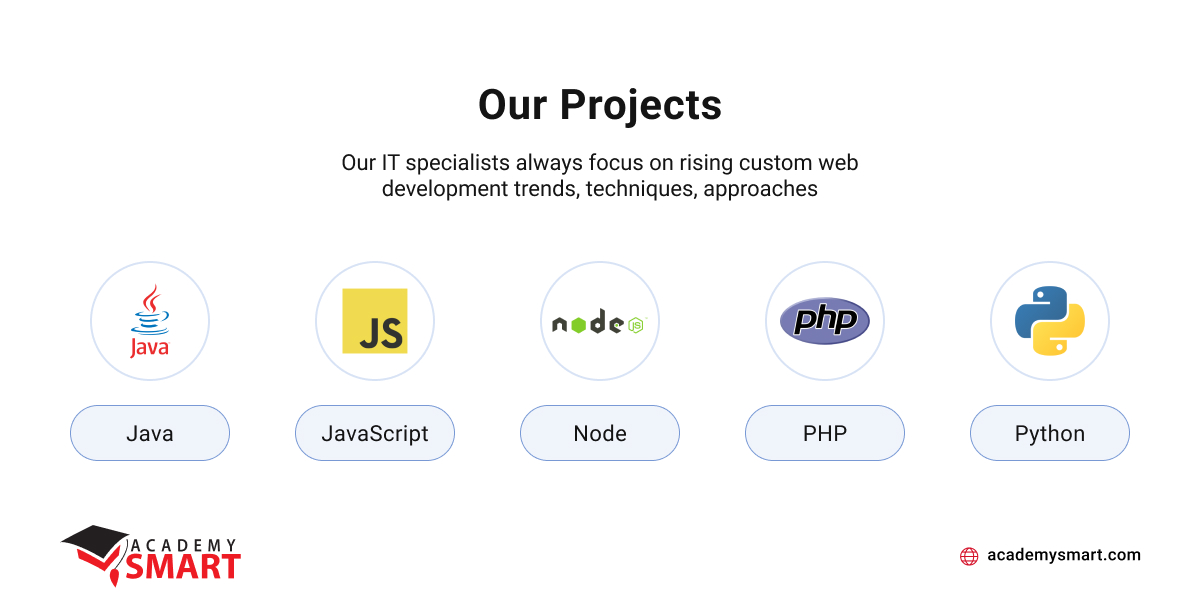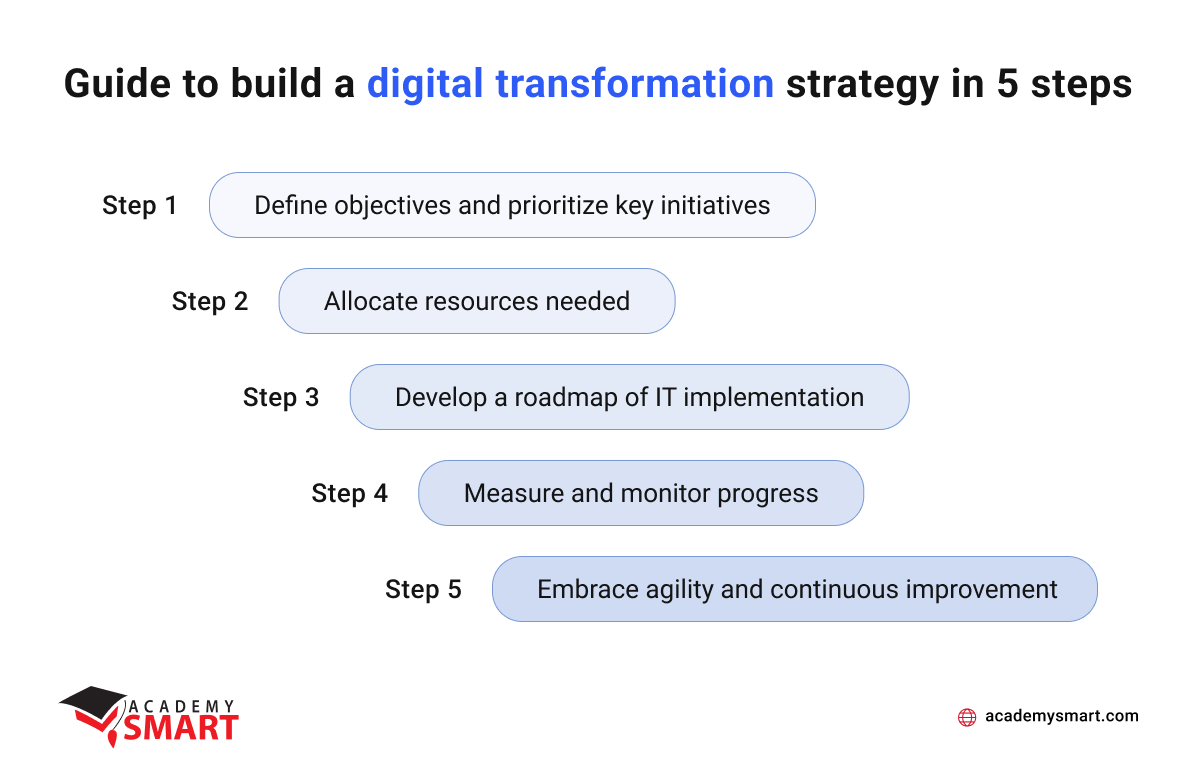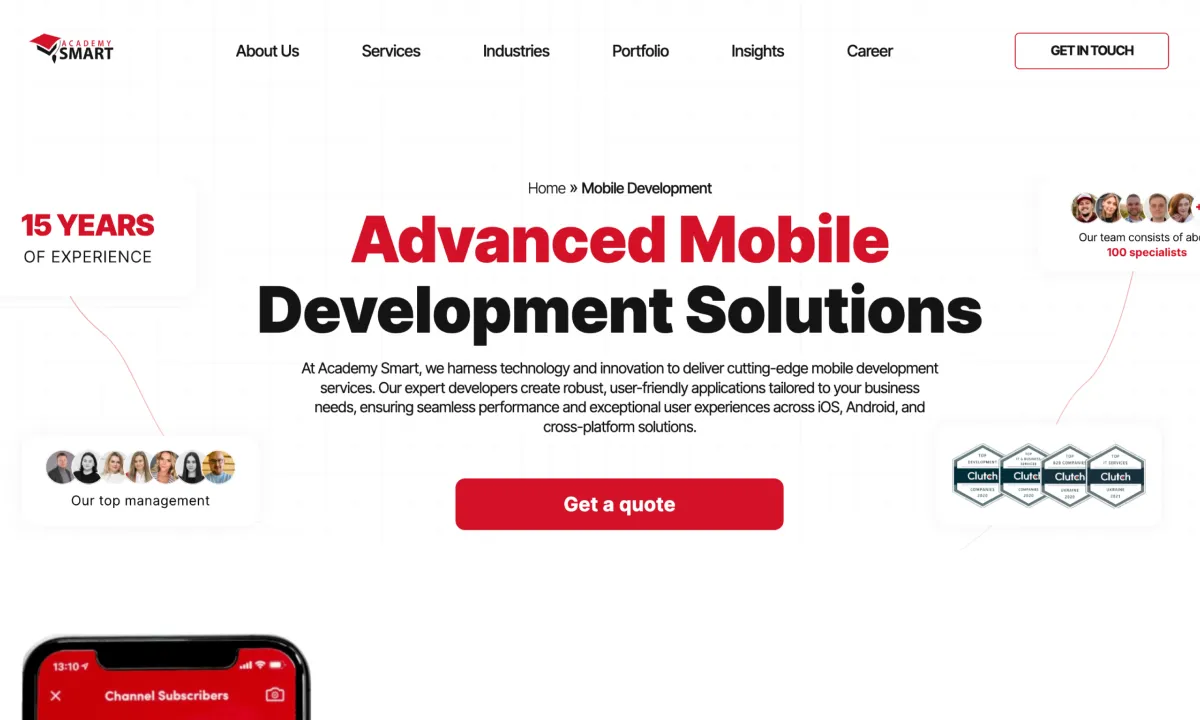
What is Digital Transformation: definition, strategy, examples
Contents
The digitization of society’s life has rapidly accelerated in the last few years, making it imperative for companies across industries to embrace digital transformation strategies. We all remember how the COVID-19 pandemic restrictions forced businesses to virtualize their operations and find innovative ways to engage with customers, employees, partners, and suppliers. So now, many companies recognize the importance of digital transformation to stay in demand.
However, bringing their business processes per the digital requirements of our time is too difficult for most companies. And according to the Everest Group’s research, 78% of enterprises now have different troubles with their digital transformation. Factors contributing to their failures include lack of employee engagement, inadequate management support, data privacy and security concerns, limited in-house development expertise, budget constraints, and the challenges of replacing legacy systems.
This article explains the essence of digital transformations and offers valuable insights to increase the chances of proceeding successfully.
What is Digital Transformation
Digital transformation consistently integrates information technologies into various companies’ strategies, processes, and products. Its primary purpose is to enhance the engagement of employees and customers with modern digital tools and environments, leading to improved competitiveness. This extensive transformation involves reevaluating and reinstating all aspects of an organization, from supply chains and workflows to employee skills and customer interactions.
Successful digital transformations bring ongoing business benefits by enabling organizations to respond effectively to customer demands, both in the present and as markets evolve. Moreover, they build the necessary infrastructure and skills to capitalize on rapidly advancing technologies, gaining a business edge.
Defining digital transformation is not just about keeping up with the industry and global trends; it is a continuous journey of innovation and finding better ways of doing things. The process varies across business areas, depending on customer expectations, business models, and organizational culture. Often, it involves moving away from aging technical means, management solutions, and workflows that are losing efficiency, as well as the services associated with their support, as part of the transition to modern digital environments and new providers of IT expertise.
The transformation process conventionally can be broken down into four phases:
- of planning, partnership establishing, and capability testing;
- of defining the strategy and key performance indicators;
- of emphasizing scalability and change management;
- of ongoing innovation and improvement.
Even after completion, digital transformation requires continuous maintenance and evaluation to stay relevant and practical in an ever-evolving digital world. A well-executed digital transformation strategy ultimately positions organizations to survive and thrive in a technology-driven future.
Why is Digital Transformation important
Digital transformations are crucial for organizations due to several compelling reasons. Firstly, digitization of society has happened, necessitating businesses to adapt or face extinction. Secondly, technology’s rapid data collection, analysis, and transmission capabilities drive digital transformation. Leading world companies like Amazon and Airbnb have transformed consumer expectations, demanding quick responses, tailored products, and easy-to-use interfaces.
Moreover, digital transformation benefits organizations by:
- reducing time to market with new services and products;
- enhancing employee productivity;
- improving customer responsiveness;
- and offering personalized experiences.
It enables businesses to gain valuable insights from data to make faster, more accurate decisions in various strategic areas. Additionally, automation technologies, like RPA, relieve employees from repetitive tasks, allowing them to focus on higher-value work. Digital transformation technologies, such as cloud computing, AI, mobile platforms, and others, empower organizations to move faster, work more efficiently, and create innovative products and services.
Successful digital transformations increase ROI and provide data-driven insights for optimized operations and decision-making. Furthermore, digital tools facilitate better communication, collaboration, and improved customer experiences, ultimately leading to business growth and a competitive edge in the digital era. The presentation of helpful enterprise applications created for our clients eloquently demonstrates what digital transformation is in practice.
Digital transformation: examples
In digital transformation, success stories abound, showcasing its diverse applications across various industries. They all commonly relate to changes of processes, domains, or business models. Let’s explore some inspiring instances of top global companies, demonstrating how they harnessed strategic brainwork, innovation, and creativity to achieve remarkable growth in sales, productivity, and revenue.
Business processes transformation
This type of digital transformation refers to the strategic and technological reinvention of an organization’s operations to streamline workflows, enhance efficiency, and deliver superior customer experiences. It entails adopting cutting-edge technologies like artificial intelligence, machine learning, enhanced analytics, and big data management to optimize routine business processes. These digital transformations unlock significant value for businesses, enabling them to stay competitive and thrive today.
Successful examples include Domino’s Pizza, which revolutionized the food ordering process through online and device-based ordering, outpacing competitors and boosting sales. Nespresso embraced cloud-based CRM, offering customers seamless omnichannel access, enabling market expansion and improved sales. Manufacturers like Tesla leverage predictive analytics and AI to create lean, efficient supply chains, reducing costs and enhancing product capabilities. Similarly, Target improved its digital presence through web optimization, social media engagement, and user-friendly online ordering, ultimately attracting more customers and increasing sales.
Business models transformation
This type involves reimagining the fundamental way of delivering value in an industry using digital transformation strategies. It goes beyond process transformation and focuses on innovative ways to leverage technology and reshape traditional business models.
For instance, Netflix transformed from a DVD rental service to a highly successful online video streaming platform, offering personalized content recommendations based on customer preferences. Similarly, Uber revolutionized the transportation industry by introducing a digital platform that connects riders with drivers. This transformation disrupted traditional taxi services by offering a more convenient, transparent, and personalized ride-hailing experience through a mobile app.
Amazon’s business model transformation was evident when it shifted from an online bookstore to a multifaceted e-commerce platform offering a wide range of products beyond books. They disrupted traditional brick-and-mortar retail by introducing a digital marketplace where customers could shop for various goods conveniently, leading to the growth of their e-commerce empire.
Spotify changed the music industry by providing a digital music streaming service with a freemium model, where users could access a vast library of songs for free with ads or choose a premium subscription for additional features and ad-free listening. Airbnb transformed the hospitality industry by creating a digital marketplace that allows individuals to rent out their homes or spare rooms to travelers. This peer-to-peer model disrupted the traditional hotel industry, offering unique and localized accommodations for travelers.
Business domains transformation
That refers to the strategic expansion or diversification of a company’s core business activities into new domains or industries using digital technologies. It involves leveraging digital tools and innovations to enter new markets, offer different products or services, or cater to a broader customer base beyond the company’s traditional scope. While this is true for all digital transformations, the significance of technology management increases greatly when a company enters a new business area for itself.
Initially known for its search engine, Google expanded its business domain into various areas, such as online advertising (Google Ads), cloud computing (Google Cloud), mobile operating systems (Android), and smart home devices (Google Nest). Through digital technologies, Google diversified its portfolio and entered new fields beyond its primary search engine service. Microsoft, on the other hand, started as a software company. Still, it expanded into hardware (Surface devices), cloud computing (Microsoft Azure), and various other services like Microsoft 365 and Xbox.
While Apple initially was focused on personal computers, it shifted its primary focus by introducing innovative products like the iPhone, iPad, and App Store. These digital devices and services allowed Apple to enter the mobile device and app distribution market, significantly diversifying its business. Beginning as an online bookstore, Amazon became a major player in e-commerce, offering a vast range of products. Furthermore, in addition to leading business areas, Amazon Web Services (AWS) allowed the company to enter the cloud computing market, providing infrastructure and computing services to enterprises worldwide.

Several digital transformation examples
What is a Digital Transformation strategy
A digital transformation strategy is a comprehensive plan that outlines how an organization will leverage emerging technologies to address critical business challenges and achieve desired outcomes. It involves embracing a culture of openness to change, experimentation, and innovation. It encompasses various aspects, such as business assessment, understanding the industry and competitors, creating an execution plan with a clear roadmap, and developing a workable budget plan considering technology and other business areas.
To succeed in the digital era, companies must align their digital transformation strategy with data, processes, information, technology, and human aspects. By adopting this holistic approach, organizations can navigate the ever-transforming economic landscape, optimize business processes, develop new business models, and capitalize on digital technologies to stay strong and competitive.
A digital transformation plan can vary in length and complexity depending on the organization’s size and nature, the transformation’s scope, and the level of detail required. However, some expected sections typically found in the document may include:
- Executive summary
A concise overview of the digital transformation strategy, highlighting its purpose, objectives, and critical outcomes. This section provides a high-level summary for stakeholders who may not have time to read the entire document. - Introduction and background
This section provides context for the digital transformation, explaining why it is necessary and its alignment with the organization’s goals and vision. - Vision and objectives
Clearly outlining the idea and the objectives the digital transformation strategies aim to achieve. They should be measurable and aligned with the company’s long-term goals. - Current state assessment
A comprehensive evaluation of the organization’s state, including strengths, weaknesses, opportunities, and threats. This analysis helps identify areas that require improvement and opportunities for innovation. - Industry and competitor analysis
An examination of the industry landscape and a study of direct competitors’ digital transformation strategies. This analysis helps the organization identify market trends, potential disruptors, and areas for differentiation. - Technology and Tools
The section specifies the information technologies and stacks that will be utilized in the transformation process. It could include cloud computing, data analytics, artificial intelligence, and other relevant solutions. - Digital transformation roadmap
A detailed plan includes initiatives, projects, and actions to achieve the digital transformation objectives. This roadmap should include timelines, milestones, resource allocation, and dependencies. - Measurement and Key Performance Indicators
Defining metrics and KPIs to measure the success and progress of the digital transformation. These indicators should be aligned with the objectives set in the strategy. - Risks and mitigation strategies
It identifies potential risks and challenges during the transformation and outlines mitigation strategies to address them effectively. - Communication Plan
It outlines how the company will communicate the digital transformation strategy to internal and external stakeholders, ensuring everyone knows the initiatives and their benefits. - Management and corporate culture
This volume focuses on change management strategies, employee engagement, and fostering a culture that embraces innovation and adaptation.
A mindful approach to developing digital transformation strategies has helped our clients navigate this milestone of the companies’ growth smoothly and manageably, expand their business capabilities, and maintain and grow profits. You may find examples of their success in our portfolio.

Products delivered by Academy Smart
How To Build A Digital Transformation Strategy: 5 steps
A successful digital transformation strategy starts with a clear vision aligning digital technologies with strategic objectives and the company’s unique digital business model. This process requires combining traditional project management techniques and innovative approaches like Agile methodologies to bring the company, its culture, staff, and technologies into the new digital state. Furthermore, it is crucial to understand that digital transformations is an ongoing and iterative process requiring continuous evaluation and adjustments to maximize business value. Not less important, when implementing cutting-edge technologies, is to assure the profitable return on investment.
Step 1. Define objectives and prioritize key initiatives
The first step involves understanding the organization’s market position, trends, and current and potential customers expectations. Identifying the company’s value proposition through internal evaluation and external research is essential. The strategy should then envision the business’s future state, aligning its products and services to meet customer needs and wishes.
A crucial aspect is starting the plan from a thorough understanding of the organization’s core business purposes rather than just focusing on technology. That ensures a more practical approach to digital transformation and paves the way for successful cultural change within the organization. Tech stack selection plays a significant role in achieving digital transformation goals, and the strategy should incorporate relevant technologies, such as AI, VR, mobile, or cloud, to support the overall objectives and enhance productivity and efficiency.
Step 2. Allocate resources needed
A wise digital transformation strategy requires a well-allocated combination of financial resources, appropriate technology background, a skilled and motivated team, strategic partnerships, and considerations for potential challenges. By adequately allocating resources, companies can drive a seamless and efficient digital transformation journey toward achieving their business goals.
Allocating a sufficient budget is essential for the successful execution of the strategy. The budget should encompass technology-related costs acquisition, software and hardware infrastructure, employee training, and consulting services.
Exploration of the current infrastructure is crucial in identifying gaps and determining the priority technology for digital transformation. It involves evaluating the software and hardware systems, identifying areas for improvement, and deciding on adopting emerging technologies like ML, cloud computing, or IoT.
Be aware legacy systems and applications may hinder the changes and require careful attention at the executive-level. Companies should also consider factors like employee engagement, cross-functional collaboration, accountability, data privacy, and regulatory compliance as essential resources for successful digital transformation.
Assembling the right team is vital for the effective planning and execution of the digital transformation strategy. Key roles may usually include:
- the Chief Digital Officer (CDO) or someone responsible for the transformation, like CTO or CIO;
- business-technology liaisons who understand the organization’s objectives and technology strategy;
- evangelists to generate excitement and secure funding;
- project managers to ensure smooth implementation;
- IT teams to handle technology installation, application development, and further management.
Seeking external expertise through partnerships and consulting services can be crucial for organizations embarking on digital transformation. Partnering with technology vendors and experts who share a similar vision and can support the long-term strategy is vital. Expert guidance helps identify the right technology solutions, avoid pitfalls, and ensure reliable implementation. So, you have to utilize this resource too.
Step 3. Develop a roadmap of IT implementation
Not all IT ideas and initiatives can be implemented simultaneously. That’s why prioritizing based on their potential influence, complexity, and alignment with the strategic objectives of digital transformation is crucial. It helps ensure that resources are defined correctly and that high-impact projects are highlighted as paramount. Then, the organization can establish realistic timelines and the main milestones for implementing the new set of IT solutions and determine the specific sequence of tasks.
Change management is an essential consideration during roadmap digital transformation creation. The updation initiatives often involve significant changes in processes, workflows, and employee roles. Moreover, key stakeholders, such as business leaders, IT teams, and end-users, expect for accounting their perspectives and requirements in the planning process. A well-defined change management strategy ensures that the workforce smoothly adopts and accepts new IT solutions.
Step 4. Measure and monitor progress
Once the roadmap is in place and initiatives are underway, measuring and monitoring progress becomes essential to ensure the strategy’s success.
The first step in this stage involves setting KPIs that align with the digital transformation aims. They serve as benchmarks to evaluate the success and impact of the projects. They can include metrics related to customer satisfaction, revenue growth, operational efficiency, employee productivity, and other relevant areas.
Regular data collection and analysis are necessary to track the progress of the digital transformation efforts. They can be collected from various sources, including customer feedback, sales data, employee performance metrics, and system logs. Analyzing this data provides valuable insights into the effectiveness of the strategic decisions.
Continuous monitoring allows companies to detect potential issues or roadblocks that may arise during the digital transformations. Early identification of challenges enables prompt action, preventing them from escalating and hindering the overall progress of the journey.
Step 5. Embrace agility and continuous improvement
The final stage fosters a culture of flexibility, adaptability, and openness to change. Organizations must be willing to iterate and refine their digital strategies as they learn from their experiences and adapt to new challenges and opportunities in the market. Continuous improvement efforts should be driven by data and feedback, allowing the organization to make informed decisions and stay ahead of the curve. By embracing agility, organizations can ensure that their digital transformation activity remains relevant, effective, and successful in the long term.

Guide to build a digital transformation strategy
How Academy SMART can help you
You may find cooperation with us valuable, fruitful, and profitable when embarking on your digital transformation.
- Our technical experts and business analysts will help assess the viability of your ideas, and experienced project managers will provide support in drawing up realistic roadmaps for implementing information technology into your business’s structure and organizing processes.
- Our developers and DevOps will assist in reengineering current software used, integrating innovative digital tools and environments and building enterprise applications using machine learning technologies, augmented reality, cloud microservices, the Internet of Things, and advanced web or mobile full-stack development solutions.
- Our HR specialists will select the best candidates to expand your in-house staff or assemble a full-fledged turnkey app development team.
We work in a European way, with high quality, at a Ukrainian price. Submit your request to start tackling the challenges of your digital transformation today.
Digital Transformations: Frequently Asked Questions
What is Digital Transformation strategy summary?
A digital transformation strategy is a complex and coordinated plan that leverages emerging technologies to reinvent and optimize business processes, improve customer experiences, and drive innovation, ensuring an organization’s success in the digital era.
What are the key elements of a Digital Transformation Strategy?
They include a clear vision and objectives, a thorough assessment of the organization’s current state, a detailed roadmap with specific initiatives and timelines, a focus on change management and culture, and defined metrics and KPIs to measure implementation progress.
Book a free consultation

Reach out to start talking today!











